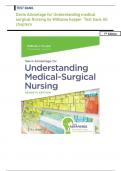TEST BANK.
Davis Advantage for Understanding medical
surgical Nursing by Williams hopper Test bank All
chapters
7th Edition
,Table of Contents
TEST BANK.................................................................................................................................................... 1
Davis Advantage for Understanding medical surgical Nursing by Williams hopper | Test
bank All chapters ............................................................................................................................................ 1
Chapter 1. Critical Thinking, Clinical Judgment, and the Nursing Process.................................... 4
Chapter 2. Evidence-Based Practice ......................................................................................................... 1
Chapter 3. Issues in Nursing Practice ................................................................................................... 20
Chapter 4. Cultural Influences on Nursing Care.................................................................................... 1
Chapter 5. Complementary and Alternative Modalities ..................................................................... 21
Chapter 6. Nursing Care of Patients With Fluid, Electrolytes, and Acid–Base Imbalances ...... 1
Chapter 7. Nursing Care of Patients Receiving Intravenous Therapy ............................................. 1
Chapter 8. Nursing Care of Patients With Infections ............................................................................ 1
Chapter 9. Nursing Care of Patients in Shock ........................................................................................ 1
Chapter 10. Nursing Care of Patients in Pain ....................................................................................... 23
Chapter 11. Nursing Care of Patients With Cancer.............................................................................. 22
Chapter 12. Nursing Care of Patients Having Surgery ...................................................................... 23
Chapter 13. Nursing Care of Patients With Emergent Conditions and Disaster/Bioterrorism
Response ........................................................................................................................................................ 28
Chapter 14. Developmental Considerations and Chronic Illness in the Nursing Care of
Adults ............................................................................................................................................................... 16
Chapter 15. Nursing Care of Older Adult Patients ............................................................................... 17
Chapter 16. Patient Care Settings ............................................................................................................. 21
Chapter 17. Nursing Care of Patients at the End of Life..................................................................... 16
Chapter 18. Immune System Function, Data Collection, and Therapeutic Measures ................ 19
Chapter 19. Nursing Care of Patients With Immune Disorders........................................................ 16
Chapter 20. Nursing Care of Patients With HIV Disease and AIDS................................................ 37
Chapter 21. Cardiovascular System Function, Data Collection, and Therapeutic Measures .. 22
Chapter 22. Nursing Care of Patients With Hypertension ................................................................ 26
Chapter 23. Nursing Care of Patients With Valvular, Inflammatory, and InfectiousCardiac or
Venous Disorders ........................................................................................................................................ 25
Chapter 24. Nursing Care of Patients With Occlusive Cardiovascular Disorders .................... 36
Chapter 25. Nursing Care of Patients With Cardiac Dysrhythmias ............................................... 28
Chapter 26. Nursing Care of Patients With Heart Failure ................................................................ 23
Chapter 27. Hematological and Lymphatic System Function, Data Collection, and
Therapeutic Measures ................................................................................................................................. 21
Chapter 28. Nursing Care of Patients With Hematological and Lymphatic Disorders ............. 16
Chapter 29. Respiratory System Function, Data Collection, and Therapeutic Measures ........ 28
Chapter 30. Nursing Care of Patients With Upper Respiratory Tract Disorders ....................... 28
Chapter 31. Nursing Care of Patients With Lower Respiratory Tract Disorders ........................ 19
Chapter 32. Gastrointestinal, Hepatobiliary, and Pancreatic Systems Function, Data
,Collection, and Therapeutic Measures .................................................................................................. 25
Chapter 33. Nursing Care of Patients With Upper Gastrointestinal Disorders .......................... 22
Chapter 34. Nursing Care of Patients With Lower Gastrointestinal Disorders .......................... 21
Chapter 35. Nursing Care of Patients With Liver, Pancreatic, and Gallbladder Disorders .... 25
Chapter 36. Urinary System Function, Data Collection, and Therapeutic Measures .................18
Chapter 37. Nursing Care of Patients With Disorders of the Urinary System ............................18
Chapter 38. Endocrine System Function and Data Collection ......................................................... 17
Chapter 39. Nursing Care of Patients With Endocrine Disorders ...................................................18
Chapter 40. Nursing Care of Patients With Disorders of the Endocrine Pancreas .................. 20
Chapter 41. Genitourinary and Reproductive System Function and Data Collection................ 22
Chapter 42. Nursing Care of Women With Reproductive System Disorders............................... 17
Chapter 43. Nursing Care of Male Patients With Genitourinary Disorders.................................. 17
Chapter 44. Nursing Care of Patients With Sexually Transmitted Infections................................ 1
Chapter 45. Musculoskeletal Function and Data Collection ............................................................. 17
Chapter 46. Nursing Care of Patients With Musculoskeletal and Connective Tissue
Disorders ......................................................................................................................................................... 17
Chapter 47. Neurologic System Function, Data Collection, and Therapeutic Measures .......... 17
Chapter 48. Nursing Care of Patients With Central Nervous System Disorders ....................... 17
Chapter 49. Nursing Care of Patients With Cerebrovascular Disorders ........................................ 1
Chapter 50. Nursing Care of Patients With Peripheral Nervous System Disorders ................... 1
Chapter 51. Sensory System Function, Data Collection, and Therapeutic Measures: Vision
and Hearing .................................................................................................................................................... 17
Chapter 52. Nursing Care of Patients With Sensory Disorders: Vision and Hearing ................ 21
Chapter 53. Integumentary System Function, Data Collection, and Therapeutic Measures ... 21
Chapter 54. Nursing Care of Patients With Skin Disorders ................................................................ 1
Chapter 55. Nursing Care of Patients With Burns ................................................................................. 1
Chapter 56. Mental Health Function, Data Collection, and Therapeutic Measures .................... 13
Chapter 57. Nursing Care of Patients With Mental Health Disorders............................................ 13
, Chapter 1. Critical Thinking, Clinical Judgment, and the Nursing Process
Multiple Choice
Identify the choice that best completes the statement or answers the question.
1. The nurse is caring for a group of patients on a medical–surgical unit. The
licensed practical nurse/licensed vocational nurse (LPN/LVN) assesses
the patient experiencing a low blood glucose first. Which process was
needed to make this decision?
1. Application of clinical judgment
2. Recommendation of the registered nurse (RN)
3. Understanding of what regulates blood glucose levels
4. Knowing the patient’s past medical history
ANS: 1
Chapter: Chapter 1. Critical Thinking, Clinical Judgment, and
the Nursing Process Objective: 7. Explain the difference
between critical thinking and clinical judgment. Page: 2
Heading: Clinical Judgment
Integrated Process: Clinical Problem-Solving
Process (Nursing Process) Client Need: SECE:
Coordinated Care
Cognitive Level:
Comprehension
[Understanding] Concept:
Clinical Judgment
Difficulty: Difficult
Feedback
1 Clinical judgment is the observed outcome of critical thinking and
decision
making. The nurse identified the patient at high risk and decided to
assess this person first.
2 The LPN/LVN needs to make clinical decisions independently from the
RN.
3 Understanding the pathophysiology of the disease does not
determine how decisions are made.
4 Past medical history is important, but the current clinical cues will
determine prioritized nursing actions.
PTS: 1
CON: Patient-Centered Care




